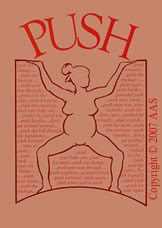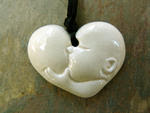-- Jim Berg, MD
…apparent disadvantages of the obstetric approach have such large order of magnitude, that in any clinical trial it would be considered unethical to continue with the obstetric treatment.
-- Peter F Schlenzka
Links to Schlenzka's Stanford dissertation, "Safety of Alternative Approaches to Childbirth." are at
http://www.vbfree.org/docs/safety.rtf
At 3:47 AM, frumiousb said...
Something that I learned during my recent pregnancy is that doctors really have their hands tied when it comes to drugs in pregnancy. No drugs are tested on pregnant women, so no drugs are safe. There is no money for drugs and pregnant women, so virtually all medication for pregnancy is being used off-register. Our understanding of their effects is only in retrospect. When it comes to the pain killers, it is almost easy enough to say don't take them. However, when it comes to other conditions requiring medication, doctors are often forced to choose between an unknown and theoretical risk and the real risk of pregnancy loss. Unenviable.
In The Vulnerable Prenate, Emerson states, “whenever there is significant prenatal stress (trauma), there is an increasing statistical likelihood that birth complications will occur. The greater the degree of stress or trauma during the prenatal period, the greater the likelihood of birth complications and obstetrical interventions.”
The work of Emerson and Castellino show us how medical interventions contribute to birth trauma in the imprinting process. Just as significantly, perhaps even more so, is their contribution to understanding the importance of the prenatal period as creating the imprints that will be expressed at birth. Specifically, the mother’s emotional, physical, and psychological, and spiritual well-being is now documented as contributing to birth trauma. How a woman cares for herself and her unborn, how she feels about the pregnancy, how much and what kind of support she has for bringing a new life into the world, and her previous traumas and experiences all create the imprints for her baby’s birth experience. All of these create the baby’s birth experience.
Society's first reaction is that mother's are to blame mothers for the prenatal period and doctor's are to blame for anything that goes wrong during labor and birth. Doctor's have "deep pockets" and the know-how and control in labor and birth and are disproportionately held responsible for the "outcome" of a baby and his or her birth.
My intention with this series of quotes is to propose that women and medicine must become partners in birth. Women (especially expectant mothers who must claim their power and responsibility in conceiving, gestating, and birthing their babies) and medical providers (who must stop the justifying of medical management of birth as they practice “malpractice avoidance”) should know this research information. They must know the research about medical birth practices and the social consequences that weave through every aspect of our lives. Women can begin individually, in the birthing of their babies, to create partnerships with medicine and technology by claiming both their power and their responsibility for their baby’s birth. Physicians, as called for here by a physician and a colleague, must enter the political, social arena of participating to create solutions.
Civil society grappling with issues of equity and humaneness, in which health care is one of the most central concerns, desperately needs physician input and physician participation.
-- David J. Rothman, Ph.D. and Tom O’Toole, M.D.,
“Physicians and the Politic Body”
An excerpt from “Physicians and the Politic Body”by David J. Rothman, Ph.D. and Tom O’Toole, M.D. on the website, “Ideas for an Open Society.” From OSI-U.S. programs.
What is to be done?
The capacity of the medical profession to resolve these dilemmas depends on at least two considerations: responsiveness to professional values and new commitment to advocacy. Let us spell out precisely what that would mean.
Physicians know well how to take care of patients. What is required of them is a broadened definition of what that care entails. It has to include not only gaming the system for one patient but advocating this patient’s general interests. Physicians need the skills and the commitment to translate their own feelings of frustration into an agenda of greater accountability from the profession itself, insurers, and society-at-large. Physicians must challenge a system of care that is structured on behalf of shareholders and speak out setting new national health care priorities. If the medical profession is to fulfill the covenant that exists between the doctor and patient, a new order of professionalism marked by advocacy and collective action has to emerge.
To this end:
- Medical schools and residency programs should reform the education and clinical training of physicians to incorporate advocacy and skill development and provide both a broader and more directed sense of professionalism and societal responsibility in the curriculum.
- Physicians must transform their professional societies into organizations that advocate on behalf of patients. Medical societies should not be in the pockets of corporate interests or driven exclusively by members’ financial interests. Infusing idealism and leadership within professional organizations can bring like-minded physicians together and give them a stronger collective voice. Models do exist, as in the case of the American Academy of Pediatrics and the Society of General Internal Medicine.
- Consumer and general advocacy organizations should break their own insularity and seek physician participation. Doctors can be powerful allies and they should be invited into the ranks of change-minded people.
http://www.soros.org/resources/articles_publications/
publications/ideas_physicians_20020101 (sorry, need to cut and paste)
If we all were to focus on the needs of the baby to have an aware and welcoming conception, a safe and loving gestation, and a gentle and peaceful labor and birth, what would a woman, and her partner, need from us as a society?








1 comment:
I have been thinking about this intently for a couple of years -- how to create partnerships between women and doctors in order to make birth safe for the baby, the mother, and the caregiver.
A plan I developed can be viewed at:
http://www.safebabyresolution.blogspot.com/
Post a Comment